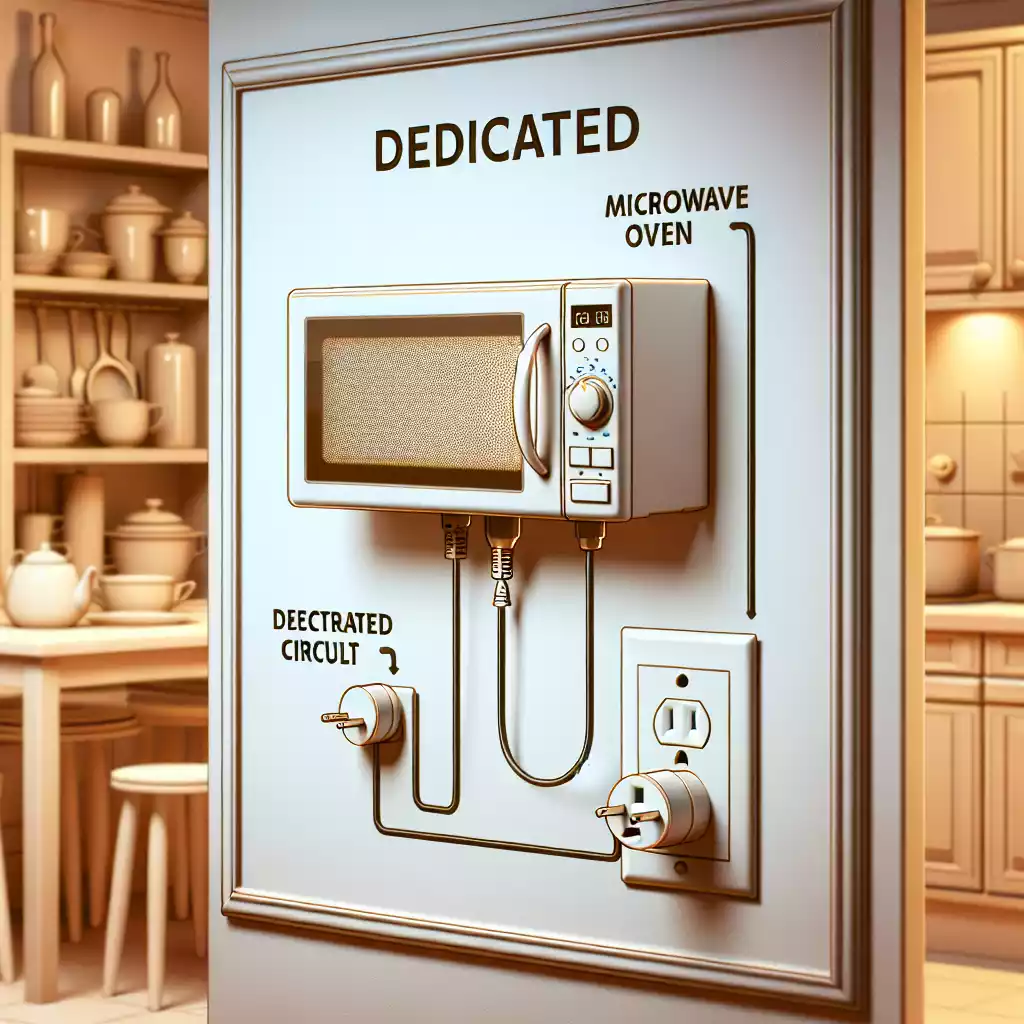Understanding Microwave Electrical Requirements
Microwaves have become a kitchen staple, making meal prep quick and easy. But, have you ever thought about the electrical demands of these handy appliances? Understanding whether your microwave needs its own circuit can save you from potential electrical hazards. Back in the day, kitchens had fewer appliances, and homes were wired accordingly. Today, with the advent of modern kitchen gadgets, the electrical load has increased significantly.
What is a Dedicated Circuit?
A dedicated circuit is a circuit that serves only one appliance. It ensures that the appliance gets the power it needs without sharing the circuit with other devices. This is crucial for high-power appliances like refrigerators, ovens, and, yes, microwaves. Dedicated circuits help prevent overloads and ensure safety.
Electrical Safety Standards
Overview of NEC (National Electrical Code)
The National Electrical Code (NEC) sets the standard for electrical safety in the United States. It mandates that certain appliances must have dedicated circuits. Adhering to these standards is not just about compliance; it’s about ensuring your home’s safety.
Importance of Adhering to Electrical Codes
Ignoring these codes can lead to serious risks, including electrical fires and damage to your appliances. Always check the NEC guidelines when installing or upgrading kitchen appliances.
Identifying Circuit Requirements
How to Determine if Your Microwave Needs a Dedicated Circuit
Not all microwaves are created equal. Some may require a dedicated circuit, while others might not. Check the manufacturer’s instructions to find out the specific electrical requirements for your model.
Tools and Resources for Identifying Circuit Requirements
• User Manual: Always start with the user manual.
• Multimeter: Useful for checking the current load on your existing circuits.
• Electrician: When in doubt, consult a professional.
Risks of Not Using a Dedicated Circuit
Potential Hazards and Risks
Failing to use a dedicated circuit for your microwave can lead to several issues, including frequent tripping of breakers and potential fire hazards.
Real-Life Examples of Electrical Issues
Consider the case of a homeowner who ignored the dedicated circuit requirement. They experienced frequent power outages and eventually an electrical fire. Don’t let this be you.
Overloading Circuits
Causes and Effects of Circuit Overload
Overloading occurs when too many appliances draw power from a single circuit. This can cause breakers to trip and even lead to electrical fires.
Signs Your Circuit May Be Overloaded
– Frequent breaker trips
– Flickering lights
– Warm or discolored outlets
Electrical Fires and Damage
How Improper Circuits Can Lead to Fires
Using a shared circuit for high-power appliances increases the risk of electrical fires. The wiring can overheat, leading to potential fire hazards.
Preventative Measures to Avoid Electrical Fires
– Use dedicated circuits for high-power appliances
– Regularly inspect your electrical system
– Consult an electrician for upgrades
Installing a Dedicated Circuit for Your Microwave
Steps to Install a Dedicated Circuit
1. Turn off the Power: Always start by turning off the main power.
2. Install a New Breaker: Add a new breaker to your electrical panel.
3. Run the Wiring: Run the appropriate gauge wire from the panel to the outlet.
4. Install the Outlet: Connect the wiring to a new outlet.
Necessary Tools and Materials
– Breaker
– Electrical wire
– Outlet
– Screwdrivers
– Wire strippers
Hiring a Professional vs. DIY
Pros and Cons of Professional Installation
Pros:
– Guaranteed safety
– Compliance with codes
– Professional expertise
Cons:
– Higher cost
DIY Tips and Safety Precautions
Pros:
– Cost-effective
– Sense of accomplishment
Cons:
– Requires knowledge and skills
– Potential safety risks
Cost Considerations
Average Costs for Professional Installation
Professional installation can range from $200 to $500, depending on your location and the complexity of the job.
Budgeting for DIY Installation
DIY costs are generally lower, typically around $50 to $100 for materials. However, ensure you have the necessary skills to complete the job safely.
Variations in Microwave Power Requirements
Differences in Microwave Wattages
Microwaves come in various wattages, typically ranging from 600 to 1200 watts. Higher wattage models may require more power and, consequently, a dedicated circuit.
How Power Requirements Affect Circuit Needs
Higher wattage microwaves draw more current, making a dedicated circuit essential to prevent overloads and ensure efficient operation.
Built-in vs. Countertop Microwaves
Differences in Electrical Requirements
Built-in microwaves often have higher power requirements compared to countertop models. They usually need a dedicated circuit to operate safely.
Installation Considerations for Each Type
• Built-in: Typically requires professional installation and a dedicated circuit.
• Countertop: May not always need a dedicated circuit but check the manufacturer’s guidelines.
Microwave Wattage and Circuit Needs
How to Match Microwave Wattage to Circuit Capacity
To determine if your microwave needs a dedicated circuit, check its wattage and compare it to the circuit’s capacity. A 15-amp circuit can handle up to 1800 watts, but it’s best to leave some headroom.
Examples of Wattage and Corresponding Circuit Needs
– 600-watt microwave: May not need a dedicated circuit
– 1200-watt microwave: Likely requires a dedicated circuit
Common Mistakes to Avoid
Frequent Errors in Microwave Installation
– Ignoring manufacturer guidelines
– Using an undersized circuit
– Overloading existing circuits
Tips to Ensure Proper Electrical Setup
– Always follow the manufacturer’s instructions
– Use the correct gauge wire
– Consult an electrician if unsure
Misunderstanding Circuit Load
How to Properly Calculate Circuit Load
To calculate the load, add up the wattages of all appliances on the circuit and divide by the voltage (usually 120V). This gives you the current load in amps.
Common Misconceptions About Electrical Load
Many people think they can plug multiple high-power appliances into a single circuit without issue. This is a recipe for disaster.
Ignoring Manufacturer Guidelines
Importance of Following Manufacturer Instructions
Manufacturers provide guidelines to ensure the safe and efficient operation of their appliances. Ignoring these can void warranties and create safety hazards.
Examples of Manufacturer Guidelines for Microwave Installation
• Dedicated Circuit Requirement: Many manufacturers specify this.
• Proper Ventilation: Ensures the microwave operates efficiently.
• Correct Outlet Type: Grounded outlets are often required.
FAQs
Can I plug my microwave into any outlet?
No, not all outlets can handle the power requirements of a microwave. Check if your microwave needs a dedicated circuit.
What happens if I don’t use a dedicated circuit?
You risk overloading the circuit, which can lead to frequent breaker trips, electrical fires, and damage to your microwave.
How do I know if my microwave is overloading the circuit?
Signs include frequent breaker trips, flickering lights, and warm or discolored outlets.
Is it expensive to install a dedicated circuit?
Professional installation can range from $200 to $500, while DIY costs are generally lower but require electrical knowledge.
Can I use an extension cord for my microwave?
Using an extension cord is not recommended as it can lead to overheating and potential fire hazards. Always use a proper outlet.
Conclusion

Understanding the electrical requirements of your microwave is essential for safety and efficiency. A dedicated circuit ensures that your appliance operates without risking overloads or electrical fires. Always follow the manufacturer’s guidelines and consult an electrician for any doubts. Proper installation not only protects your home but also extends the life of your microwave.

